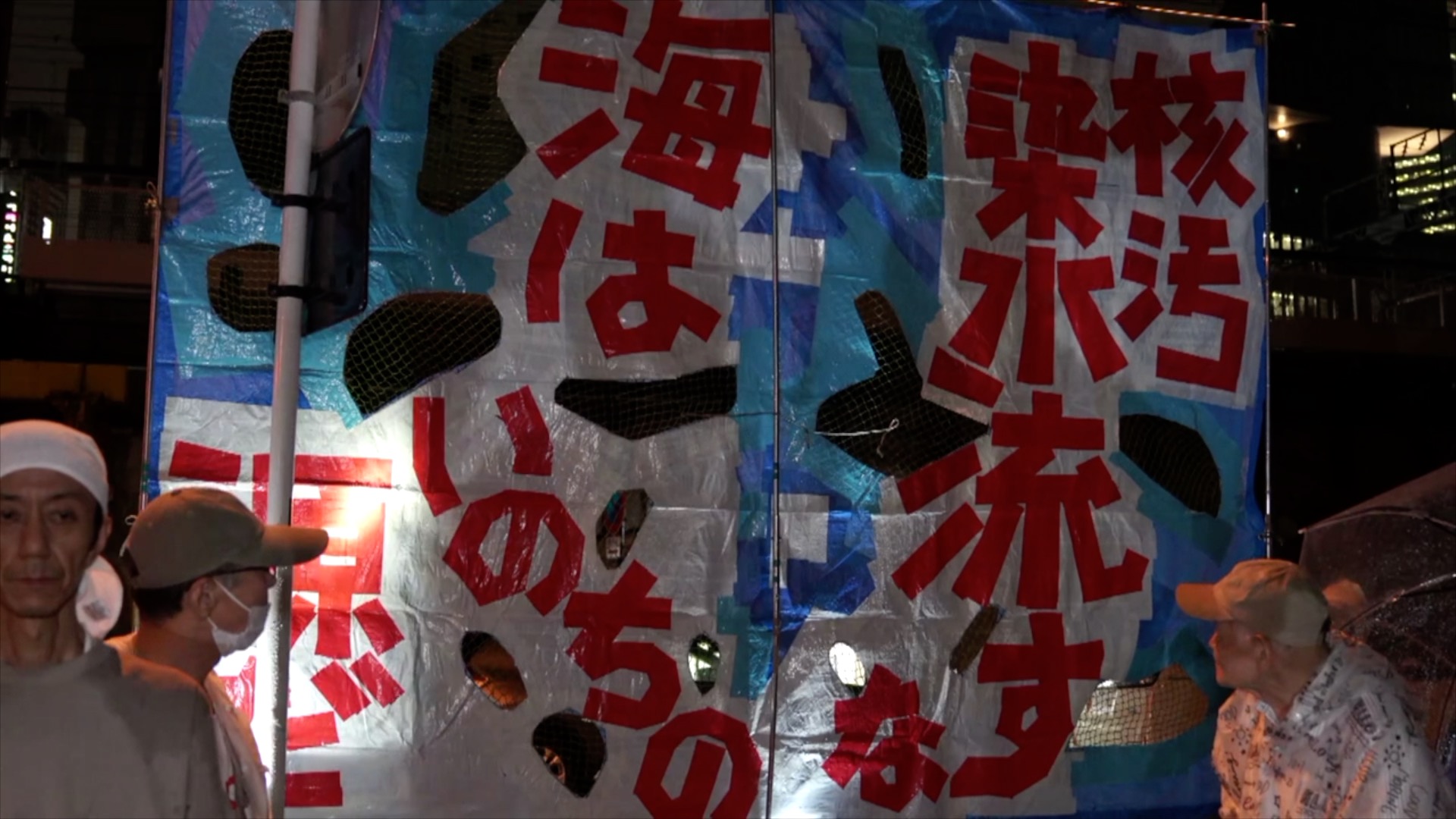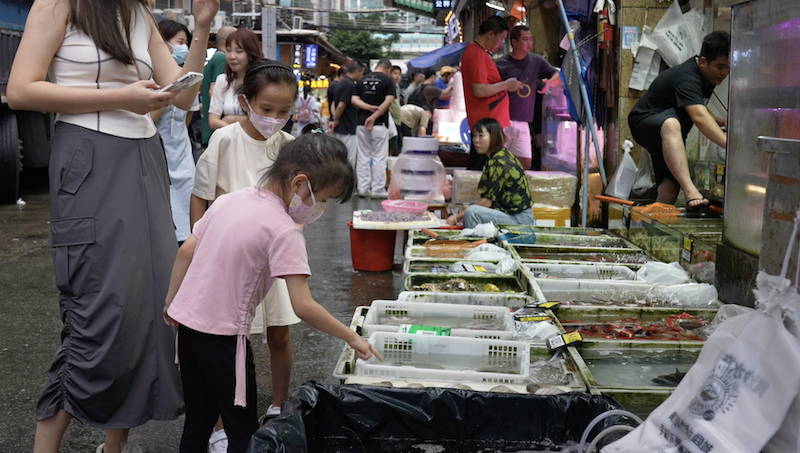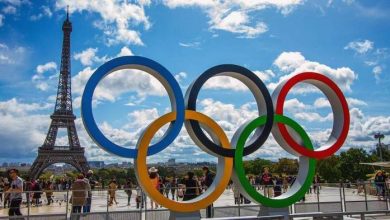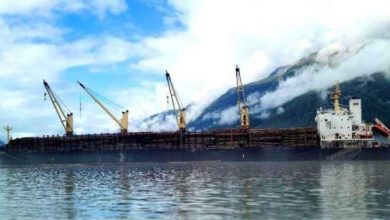Japan’s 2nd Fukushima dumping amplifies industrial “butterfly effect”

[ad_1]
Despite mounting opposition from local fishermen and other countries, Japan started the second round of its release of nuclear-contaminated wastewater on Thursday, amplifying industrial “butterfly effect” at home and abroad.
The discharge commenced at around 10:30 a.m. local time, from the crippled Fukushima Daiichi Nuclear Power Plant into the Pacific Ocean, according to the Tokyo Electric Power Company (TEPCO).
The plant’s operator said it plans to carry out the release over 17 days to discharge 7,800 tonnes of the radioactive wastewater, roughly the same amount as in the first discharge, which ended on September 11.
The release will continue for at least 30 years, and the TEPCO plans to discharge more than 31,000 tonnes of diluted toxic water in four rounds by the end of March 2024.
After the first phase of discharge, China and South Korea suspended imports of all Japanese aquatic products. Russia tightened the control over the supply of fish and other seafood from Japan.
In addition, Thailand said it will “double the amount of seafood samples collected for radioactive material search, to boost consumer confidence in their safety.”
Malaysia’s Health Director-General Muhammad Radzi Bin Abu Hassan also said in a statement that the ministry will impose “a Level-4 (Surveillance) inspection at the country’s entry points on high-risk food products imported from Japan for the analysis of radioactive material content.”
And the U.S. was “making the biggest moves in decreasing imports of agricultural and aquatic products from Japan in the first half of 2023,” according to media reports based on data from Japan’s Ministry of Agriculture, Forestry and Fisheries.
Industrial “butterfly effect”
The negative impact of Japan’s nuclear-contaminated wastewater discharge continues to spread.
Overall, the controversial decision has caused significant economic losses to fishery and tourism sectors for Japan, as well as its neighboring nations.
In the past decade, Japan’s total exports of aquatic products has maintained a generally upward trend.
The year-on-year increase in 2021 has reached 35.5 percent. In 2022, Japan’s total exports of aquatic products reached $1.97 billion.
However, judging from the current situation, this growth will soon come to an abrupt end.
In fact, the seafood ban by China and South Korea – two of the most significant importers of Japanese aquatic products – would affect hundreds of millions worths of Japanese exports in the coming years.
According to Kyodo News, in the past half month, the Japanese government has set up a fund of 80 billion yen (about $535 million) to support the aquatic industry affected by the Fukushima dumping.
Fish markets and sushi restaurants in China are distancing themselves from Japanese seafood imports after China announced a ban following the release of radioactive wastewater from the Fukushima nuclear plant.
Guangzhou’s Huangsha market, the largest wholesale market for fresh seafood and aquatic products in China, said it has stopped selling Japanese goods since August 24.
Across the city, many Japanese restaurants are making it clear they have also complied with the rules, even going as far as replacing all Japanese ingredients, including meat and sauces.
While some seafood lovers are eager to have their last “safe” bites, others say the “conveyor belt” of Fukushima’s discharge is already in motion and there is not much they can do about it.
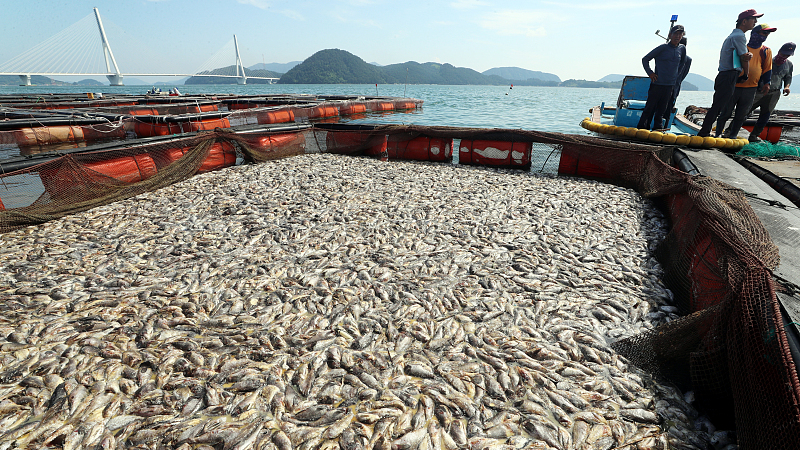
A large amount of groupers have died at fish farms in Yeosu City, South Korea, August 26, 2023. /CFP
A large amount of groupers have died at fish farms in Yeosu City, South Korea, August 26, 2023. /CFP
Residents in South Korea are also reluctant to purchase seafood at local fish markets over concerns about Japan’s ongoing nuclear-contaminated water release at Fukushima, the China Media Group (CMG) reported.
Large amounts of groupers have died in fish farms in the country’s Yeosu City due to stagnant sales and increasing water temperature, according to the report.
More than 1 million fish are dead in the city, taking up 20 percent of the total feeding amount, and amounting to losses equivalent to $11.6 million, CMG reported.
Japan’s decision to dump the radioactive water has cast a shadow over South Korea’s seafood industry. The price of the grouper has dived more than 30 percent compared to the period before Japan started releasing the water.
A local specialty known as Niphon spinosus, a type of sea bass consumed for high-end sashimi in Jeju Island, has lost its attraction with its auction price slumping by 60 percent year on year. Many seaside cities have also lost group orders of sashimi, according to CMG.
A survey conducted by Gallup Korea suggests more than seven out of 10 Koreans are concerned that the release of wastewater from Fukushima could pollute Korean waters and seafood.
Merchants at Seoul’s Noryangjin Fisheries Wholesale Market have struggled to assure the products’ safety.
“This is the worst that I’ve ever seen,” a vendor who has worked at the market for over 20 years complained, according to The Korea Times.
“There are so few people coming here that it’s ridiculous. We’re receiving not even half of the customers we used to see,” the vendor said.
Some vendors have started labeling the origin of their seafood to dispel the customers’ fears that seafood could be contaminated by the radioactive water.
“Several visitors asked me when and where the fish was caught,” another vendor said. She also mentioned people are inclined to buy frozen fish caught before the wastewater release.
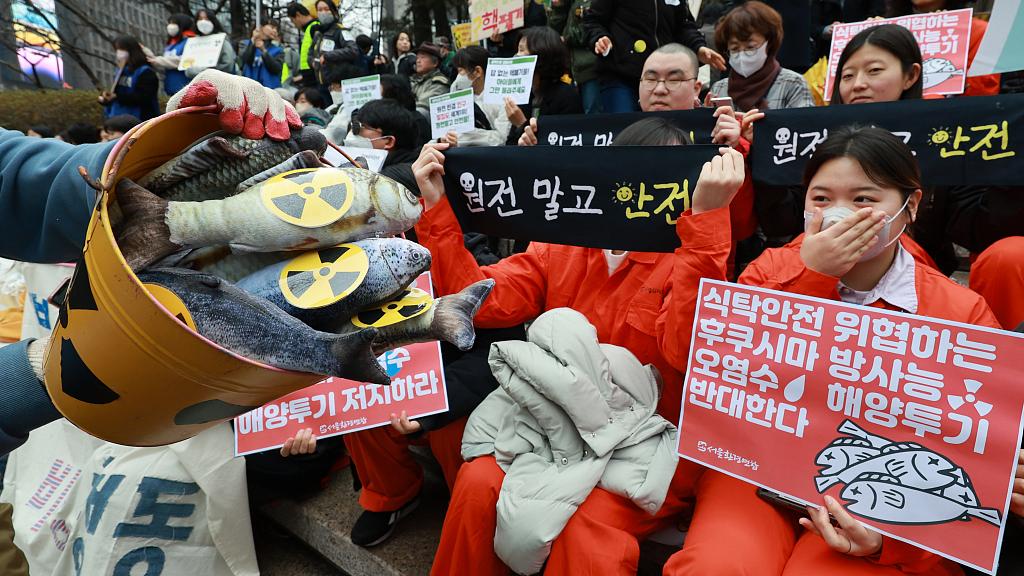
Members of civil society and environmental groups protest against Japan’s Fukushima nuclear-contaminated wastewater dumping in front of the Seoul Finance Center in Jung-gu, Seoul, South Korea, March 9, 2023. /CFP
Members of civil society and environmental groups protest against Japan’s Fukushima nuclear-contaminated wastewater dumping in front of the Seoul Finance Center in Jung-gu, Seoul, South Korea, March 9, 2023. /CFP
In addition to issues with the import and export of fisheries and related products, Japan’s tourism industry, one of the pillar industries of the country’s economy, has also been affected.
In 2003, Japan’s tourism industry entered a period of acceleration and has steadily developed into one of the major tourist destinations for world travelers.
Before the outbreak of the COVID-19 pandemic in 2019, tourism contributed approximately 7.3 percent to Japan’s gross domestic product (GDP).
Among them, tourism revenue contributed by foreign tourists’ consumption reached 4.8 trillion yen (about $32.15 billion).
Nonetheless, ever since Japan’s dumping of nuclear-contaminated water, attitudes towards traveling to Japan of people in China and other countries have been changed on major social platforms.
This sudden change may have a blow to Japan’s tourism industry.
This week, many tourists in Tokyo voiced strong dissatisfaction at Japan’s second dumping, questioning such a treatment method and expressing concerns over its potential environmental risks.
“That is not a good idea I think. So, maybe if we have other solutions, it would be better,” said a tourist from Norway.
Some people became more cautious about consuming seafood there, knowing Japan has already been releasing treated contaminated wastewater for months since late August.
“I love seafood. Japanese Sashimi, Sushi … It’s everywhere. Seafood is a staple within the culture of Japan,” said a tourist from the U.S.
“So, for those visiting, especially if you don’t know about that information about all these waste being dumped into the water, and you’re coming and consuming all these food, say you just love seafood, and you’re consuming sea food day after day, day in and day out, of course you are going to get sick,” the U.S. tourist added.
Visitors believe the environmental effects last longer than they think and will eventually damage the health of future generations.
“Last time we came here, we ate a lot of Sushi and fish. I liked it very much. But this time, with child, I think maybe not,” said a father from China.
Meanwhile, the country is striving to restore its inbound tourism to pre-pandemic levels, including finding ways to promote the safety of its food, amid oppositions surrounding their toxic water discharge issue.
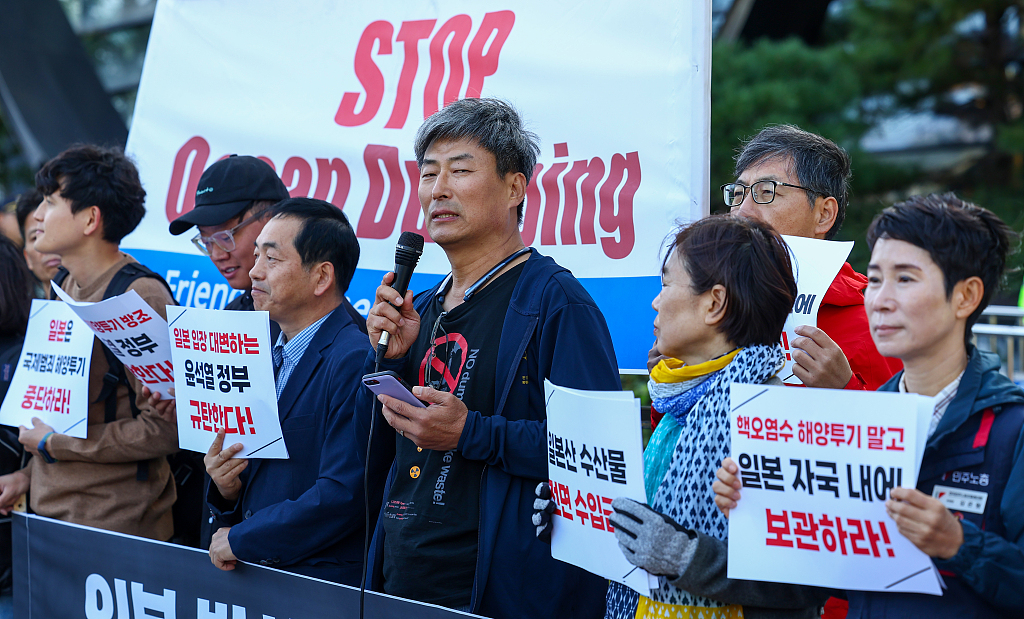
People hold signs during a rally to protest against the Japanese government’s second round of nuclear contaminated water discharge into the sea in front of the Japanese Embassy in Seoul, South Korea, October 5, 2023. /CFP
People hold signs during a rally to protest against the Japanese government’s second round of nuclear contaminated water discharge into the sea in front of the Japanese Embassy in Seoul, South Korea, October 5, 2023. /CFP
Criticisms from experts
Japan should have consulted with its neighboring countries regarding the treating of the nuclear-contaminated water from the Fukushima nuclear power plant, according to a Russian economic expert.
Leonid Grigoryev, head of World Economics Department under the National Research University Higher School of Economics, made the remarks in an interview with China Global Television Network (CGTN) in Sochi, Russia, on Wednesday.
“The Japanese government should have properly consulted with us, taken our concerns into account, allowed experts on the spot, discussed the issues and properly held a conference. Japan didn’t do any of these and discharged the nuclear-contaminated water unfriendly instead,” said Grigoryev.
The expert also said that the Fukushima accident was the result of an error in its construction.
“The nuclear plant was practically built on the beach, where the Japanese government claimed that no earthquakes greater than 6.0 magnitude would take place. But who was consulted when the Japanese government made the claim? A 10.0-magnitude earthquake and 10.0-level waves struck, flooding two cooling systems,” said Grigoryev.
In addition, environmental and geopolitical experts have criticized Japan’s latest move and called for more transparency after the country began discharging the second batch of nuclear-contaminated water.
Talking to CGTN on Thursday, Anis Bajrektarevic, a geopolitical expert from Vienna, Austria, said joint inspections and more transparency from Japan will help ease its tension with neighboring Asian countries over the issue.
“One of the possibilities, and of course this mechanism exists with the international energy agency, is that we have joint inspections. And definitely, with the neighboring countries, Japan should be more transparent and more open. I think more transparency would help and tranquilize tension,” said Bajrektarevic.
Zhang Jianyu, executive president of the Beijing-based BRI Green Development Institute (BRIGDI), said the discharge of nuclear-contaminated water will create long-term uncertainties for the environment, and warned that “dilution is not a solution.”
“I think it’s an exchange of short term economic convenience with a long term uncertainty. Because my understanding is that there are other alternatives that you can deal with this rather than just discharging,” said Zhang.
“Without a deep dive into all the other alternatives and just go to the cheapest solution is absolutely something that we should prevent from happening in the first place.”
[ad_2]
Source link


